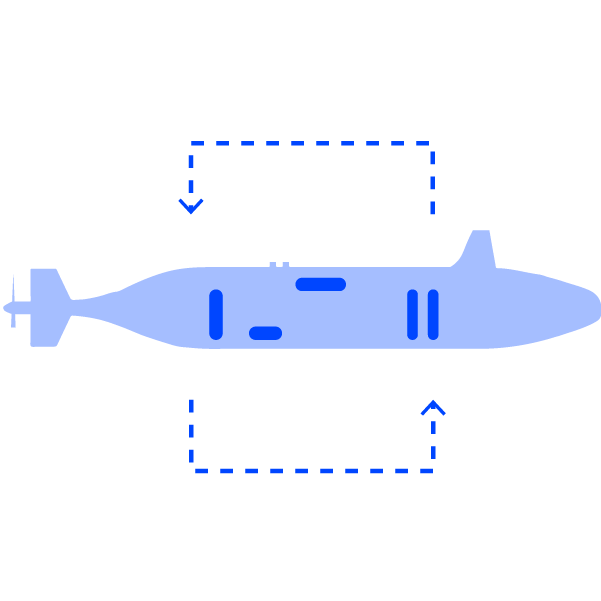UNDERWATER LASER SCANNERS
Insight Laser Scanners
Powerful underwater laser scanners for capturing incredibly detailed 3D data that improve certainty and clarity.

Proven, reliable vehicle integration options.

Our team partners with you to find the best solution

Real-time onboard data enables automation

High-resolution and accurate results
OPTICAL SENSORS
How do they work?
Underwater laser scanners (a form of underwater LiDAR) gather high-resolution optical 3D models instantaneously, without the need for lengthy processing times.
A 50° laser line is swept across the target
Points are triangulated along the laser line
Data points are calculated onboard the scanner
3D point clouds are rendered in real-time

FOR SURVEYS AND INSPECTIONS
The Lineup
Our laser scanners offer solutions for nearly every application, from short-range inspection to long-range wide-area modelling. They can be combined easily with our Imaging Systems or can come pre-integrated in our AUV Payloads or ROV Skids. No vehicle is required to operate our standalone lasers.
Insight Nano
Compact for static and dynamic scanning in small spaces on short to mid-range targets (0.13-2.5m). Scan at up to 1000m depth.
Insight Micro
A medium to long-range (1.2-7m) dynamic scanner with space for an optional integrated stills camera. Scan at up to 1000m depth.
Insight Pro
Our longest range (1.5-15m) dynamic laser scanner that produces the highest quality data. Scan at up to 6000m depth.

WIDE-AREA SURVEYS
Digital Twins
3D laser data provides virtual representations of your subsea assets, also known as a digital twin. This is especially useful in Offshore Energy applications where wide areas of critical infrastructure need to be monitored.
Data can be used as a baseline for future comparative scans to assist with predictive maintenance, or in Ocean Science applications where tracking changes over time is essential.
Stationary Scanning
Point cloud results are relative to the scanner’s position. This is typically done using our rotary actuator.

Dynamic Scanning
Uses 3rd party navigational sensors to create geo-referenced results. This is typically done from a moving vehicle.

PRECISE SCANNING
Sonar vs. Laser
Though multibeam sonar and laser line scanners are operationally similar, laser line scanners capture higher resolution data, generating with over 2000 points per line.
Sonar and underwater laser scanners can work together however, especially in Defence MCM operations, where sidescan sonar is used to detect possible targets of interest, and then optical sensors are used to identify them. The coverage that sonar provides combined with the resolution that laser scanners achieve enables a complete understanding of wide areas.


ILLUMINATE THE UNKNOWN
Enable Autonomy
The high-resolution and consistent data provided by laser scanners is well suited to automatic anomaly detection algorithms – whether that be monitoring pipeline ovality or eventing freespans and anodes.
Since your data is available in real-time, autonomous vehicles have the ability to make in-mission unsupervised decisions using the data – saving you time and money in your surveys.
Case Studies
Case Study
Empire Heritage & Hempton Marine Habitat Inspections
For Ulster University
Case Study
AUV-Based Pipeline Surveying
For Oceaneering
Still have a few questions?
Check out our frequently asked questions to learn more about using an Underwater Laser Scanner on your next project.
Do I need a vehicle to use an underwater laser scanner?
No vehicle is required – you can use the laser scanner statically using the supplied rotary actuator, or dynamically while mounted to a vehicle.
What format is the data stored in?
The data collected with our underwater laser scanners is saved in a standard format for use with any point-cloud analysis software, including the popular opensource CloudCompare.
Does water turbidity affect the results?
Yes – the scanning range will be limited by the visibility range in the water column. Talk to our experts about whether your conditions are suitable for optical inspection.
Are your laser scanners a form of LiDAR?
Yes – however there are some differences. Laser line scanning has no moving parts and therefore is more reliable and robust than LiDAR against vibration and impact.
Do I need software to use a laser?
Our ViewLS software is included which is all you need to collect and enhance your laser data. Our systems are also supported by all industry-leading survey software like EIVA NaviSuite.
Do I need other sensors?
When scanning statically, there is no need for additional sensors. For dynamic operations, you will require an inertial navigation system (INS), a doppler velocity log (DVL), a depth sensor, and a conductivity temperature depth sensor (CTD).
Ready To Get Started?
We provide versatile optical solutions to expand your underwater capability and enhance understanding of remote, challenging environments.
Proudly made in Canada 🍁
Contact Us
120 Randall Dr, Unit E
Waterloo, ON
N2V 1C6




